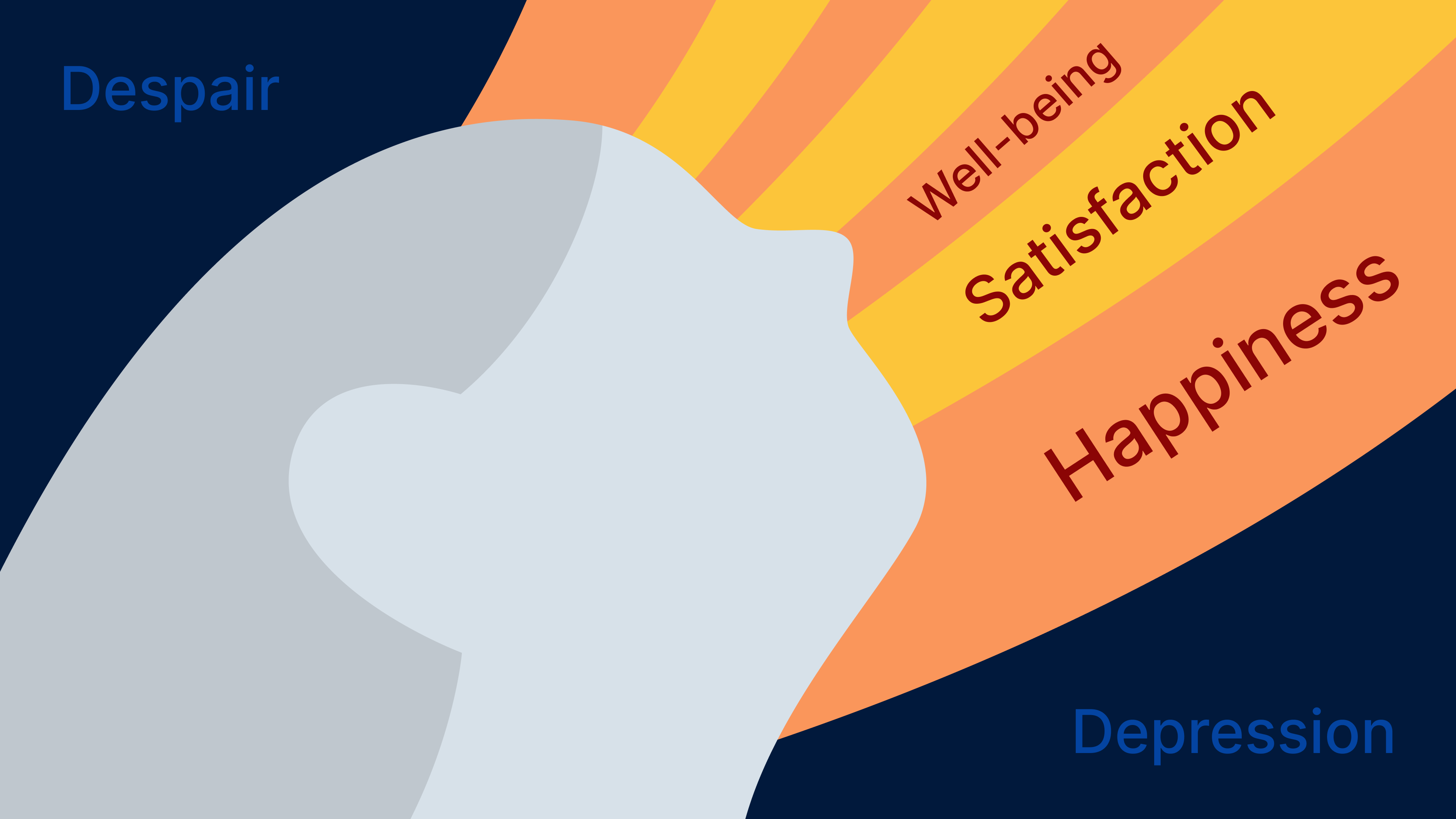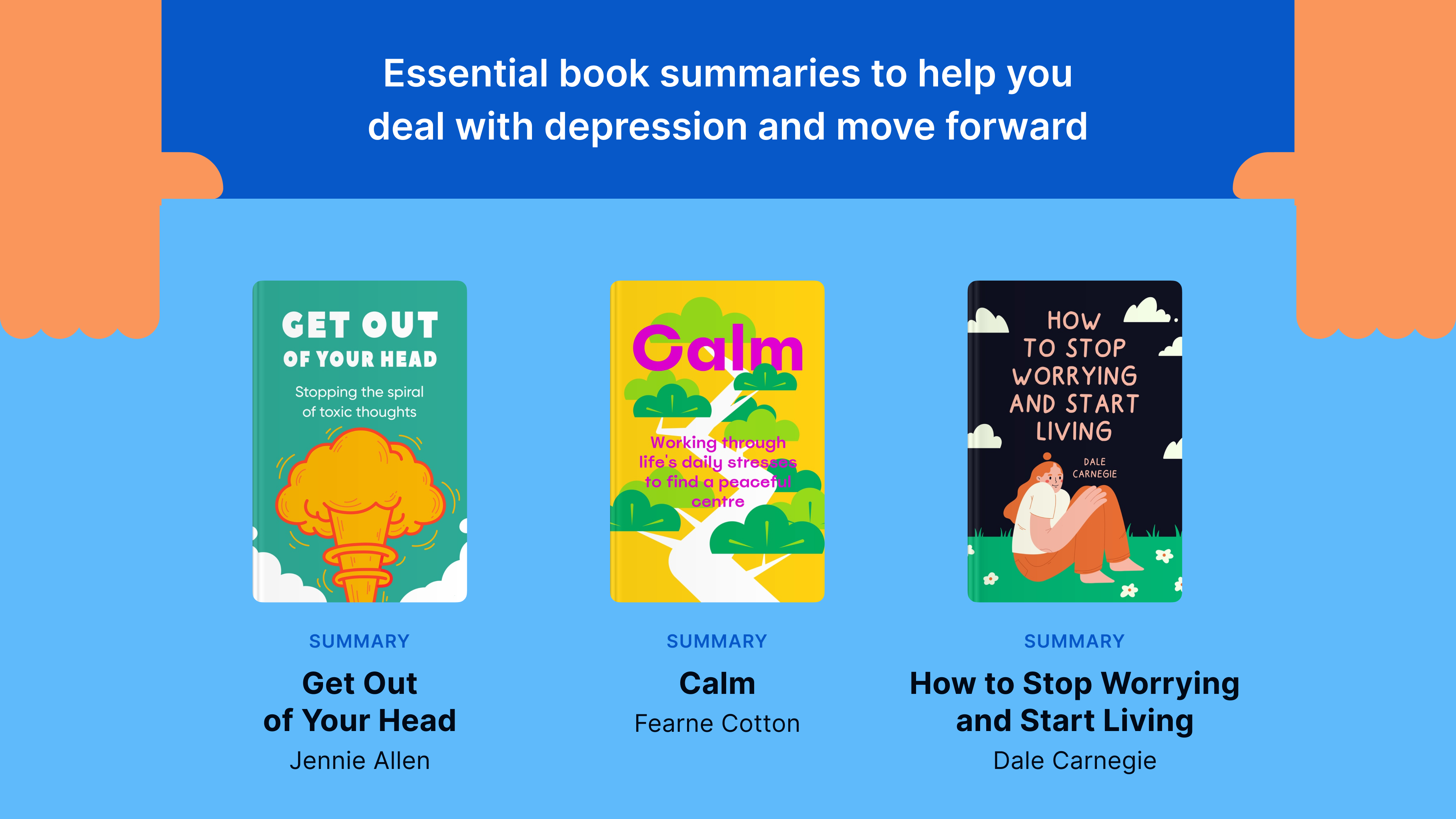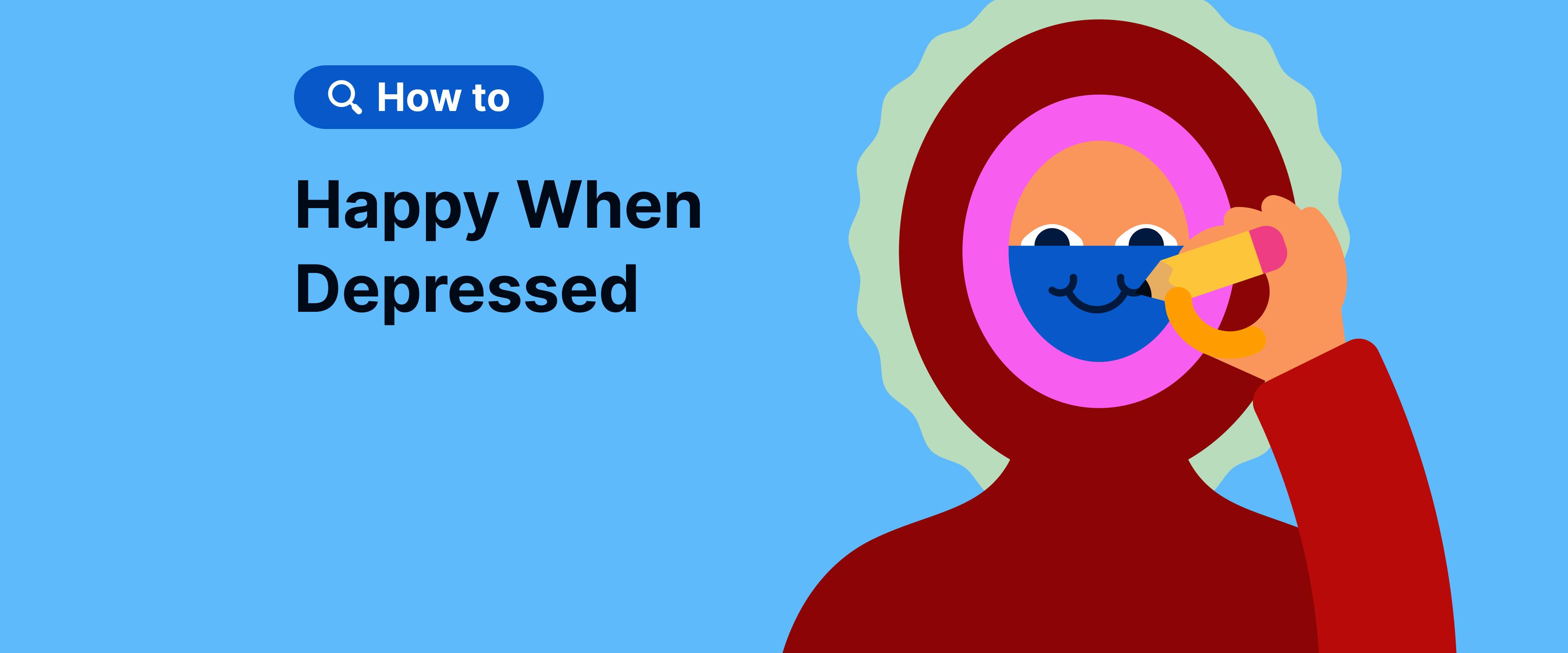When you're feeling depressed, even the word happy can feel out of reach, like a language you once knew but can't quite remember. The fog of low mood, tiredness, and constant negative thoughts can make daily life feel too much. You may feel stuck in a loop, going through the motions but disconnected from anything that once brought you joy. Getting out of bed can feel like a full-body task, smiling may feel forced, and even small social activities seem impossible.
So, can you really be happy when depressed?
Shortly - yes. Even when living with depression, it's possible to feel small moments of joy. Happiness may not erase symptoms, but it can coexist with them, and recognizing these moments helps support healing.
This guide offers practical ways to feel better while dealing with depression. You'll also find book-related tips that can support your well-being and help you move forward, including:
'Get Out of Your Head' by Jennie Allen - for quieting negative thought spirals
'Calm' by Fearne Cotton - for simple, everyday grounding
'How to Stop Worrying and Start Living' by Dale Carnegie - for classic, action-based mental resets
Table of contents:
7 practical strategies to foster happiness while depressed
The following strategies can help you start your journey toward healing.
1. Establish a gentle routine
Routine helps regulate serotonin and lowers stress. It can be especially useful for people managing mood disorders like PTSD or bipolar disorder. Some ideas include:
Brush your teeth
Put on a soft sweater
Light a candle
These simple habits soothe the nervous system and build a sense of control. Even if you skip a day, it's okay. Progress isn't perfect. Every time you return, you show yourself care — and that's part of healing.
2. Practice mindfulness
Mindfulness is a proven tool used in CBT and psychotherapy. It helps you shift from spirals of thought into the safety of the present moment.
Try this:
Pause and name five things you see or feel.
Focus on your breath or the texture of something near you.
These micro-moments ground you. Fearne Cotton's 'Calm' offers gentle prompts that support this practice. You can even do them while lying in bed. They're designed to meet you exactly where you are — no pressure, just presence.
"When you slow down, you can hear yourself again." — Fearne Cotton, 'Calm'
Related read: How to Overcome Procrastination
3. Break tasks into tiny wins
Depression affects executive functioning, so big tasks feel overwhelming. Yet, did you know that small tasks, like drinking water or replying to one message, can release endorphins? Try this:
Do one thing at a time
Celebrate each step
Focus on effort, not outcome
Even minor actions help rebuild self-esteem, and this is true whether you're on antidepressants or navigating side effects. Wins, no matter how small, add up.

4. Journal or talk it out
Expression heals. Talking to a mental health professional or simply journaling can reduce the weight of stuck emotions. Many people do not know that suppressed feelings often show up as physical symptoms, and you have the power to prevent it.
Try these prompts:
"What do I feel right now?"
"What do I need today?"
There’s no need to be a writer — just be real. You might also share with a friend or family member. Honest connection supports mental health and allows you to catch signs of depression early.
5. Find purpose in service
In many Western countries, people who suffer from depression are advised to volunteer. Helping others reminds you that you still matter! Depression often lies, saying you're a burden, but small acts can shift that. Some tips include:
Hold the door
Send a kind message
Compliment someone online
Even one kind act can reconnect you to meaning. This also aligns with self-help practices that reduce isolation and support healthy lifestyle habits.
6. Use technology mindfully
Social media can worsen symptoms of depression by fueling comparisons and overstimulation. However, when used with care, it can support well-being. Here is what you can do today:
Unfollow accounts that drain you
Follow uplifting or educational pages
Limit screen time before sleep
Try apps like Headway to explore psychology and self-care tools. Let your screen time support you, not steal from you.
![]()
7. Try a somatic, trauma-informed approach
Depression lives in the body, not just the mind. A somatic trauma-informed lens recognizes how the nervous system responds to fear, grief, or chronic stress.
People with depression often feel frozen, numb, or flat. This can stem from unresolved trauma, a long history of depression, or so-called "functional freeze" in the nervous system. The following tips may help:
Try gentle stretching
Use tapping techniques
Rest under a weighted blanket
Work with a healthcare professional or somatic therapist if possible. They can guide you safely through self-regulation, co-regulation, and mapping out your nervous system. Such an approach will allow you to address root causes, not just symptoms.
Lifestyle habits that gently support healing
There's no perfect lifestyle that cures mental health conditions. In fact, given the state of the world, nervous system dysregulations are understandable. There are habits that support regulation or a sense of inner stability, especially when practiced with compassion, not pressure.
Try these gentle steps:
According to the NHS, habits like getting sunlight, moving your body, and connecting with others — even in small ways — can make a meaningful difference in emotional well-being. Try these tips:
Take a short walk or stretch for 5–10 minutes
Stick to a calming bedtime routine
Eat small, nourishing meals
Drink water regularly
Open a window for sunlight and fresh air
Self-care also means knowing when to rest emotionally. Skip the plan. Cancel the call. Say no when needed. These habits won't “fix” depression alone, but they support your nervous system and offer comfort when things feel heavy.
Mini self-reflection: Gentle questions for today
Sometimes, a good question can ease the day. Ask yourself:
What tiny action helped me feel a little better today?
When did I feel even a small moment of peace?
What thought keeps looping, and is there a kinder truth I can say instead?
These reflections support your emotional well-being. Let them lead your day gently, without pressure.
Understanding depression and happiness
People with depression often believe they can't feel happy until they're fully "better." Thankfully, that's not true. Happiness and symptoms of depression can exist at the same time. You might smile. You might laugh. You might feel good when you are around your loved ones. These moments don't cancel out your pain. They remind you it's still possible to feel good — if only for a moment.
These glimpses of joy are more than a break in the clouds. They're proof that your mind and body still remember how to feel well, even under the weight of depression. And if one moment is possible, so are many more.

After all, these moments are not just relief — they are truths that push back against the lies depression tells. They remind you that you're still here, still feeling, still capable of light.
"We can interrupt spirals by anchoring ourselves in truth." — Jennie Allen, 'Get Out of Your Head'
Types of depression
Depression looks different for everyone. Understanding the types of depression can help you or a loved one get the best care:
Major depressive disorder (MDD): Characterized by persistent low mood, fatigue, and disinterest in daily life. It's the most commonly diagnosed form of depression.
Persistent depressive disorder (PDD): A chronic, lower-level depression that lasts two years or more. It may seem less severe but can deeply affect daily functioning. It can be a so-called smiling depression: although not a clinical diagnosis, it describes people who appear outwardly fine while struggling internally. Often overlooked even by loved ones.
Bipolar disorder: Involves extreme mood swings, from emotional highs to deep lows. These shifts impact sleep, decisions, and energy levels.
Seasonal affective disorder (SAD): Linked to seasonal changes — especially winter — and often improves with light exposure and routine.
Post-traumatic stress disorder (PTSD): This can involve flashbacks, hypervigilance, and emotional numbness after trauma. Often includes depressive symptoms.
Postpartum or perinatal depression: Affects people during or after pregnancy and may interfere with bonding, self-worth, and daily tasks.
While each diagnosis differs in the Diagnostic and Statistical Manual of Mental Disorders (DSM), they can all include symptoms of depression. Naming your experience gives you power and lets others meet you with support.
Understanding risk factors and root causes
Depression is shaped by many factors — some visible, some hidden. Let's take a moment to understand these risk factors so you can meet yourself with more kindness and clarity.
Family history: If a loved one has experienced depression or other mood disorders, you may be more likely to face similar struggles. It’s not a sentence — it's just one piece of a complex puzzle.
Past trauma: Emotional neglect, physical harm, or long-term stress can create deep nervous system patterns that lead to major depressive disorder later in life.
Lifestyle stressors: Substance abuse, lack of physical activity, poor sleep, or high stress can slowly wear down your ability to cope.
Sometimes, depression starts after a significant loss or life change. Other times, it arrives with no clear cause. In all cases, it's real and valid.
Take the case of someone who just moved cities, lost a beloved pet, and was trying to keep up with work. They felt numb, couldn't sleep well, and cried over things that never used to bother them. It wasn't until a family member gently asked how they were really doing that they realized these shifts weren't just stress — they were signs of depression. Getting help changed everything.
It's also helpful to know that antidepressants, while effective for many, aren't the only answer. They're one tool in a broader picture of care that can include therapy, social support, and self-care practices that nurture both mind and body.
Knowing the root causes doesn't mean you're to blame. It means you can begin to heal with your eyes open. And healing always starts with understanding.
Book spotlight: Wisdom that moves you forward

'Get Out of Your Head' by Jennie Allen: Backed by neuroscience and personal stories, this book helps rewire thought spirals. It’s ideal for people with depression who feel stuck in their minds.
'Calm' by Fearne Cotton: Warm and practical, this book is full of exercises and reflections for self-care. Great for people with smiling depression or anyone who feels overwhelmed.
'How to Stop Worrying and Start Living' by Dale Carnegie: This timeless guide offers realistic tips for managing anxiety and stress. It pairs well with talk therapy or other self-help tools.
Why you don't have to do it alone
Major depressive disorder and other nervous system dysregulations often isolates people. But healing needs connection.
Reach out to a mental health professional if your symptoms of depression persist.
Call a crisis lifeline if you experience suicidal thoughts or urges toward self-harm.
Join a support group.
Talk to a family member.
Remember: You're not weak for asking for professional help. You're strong for recognizing what you need.
Explore more on mental health and depression.
Final thoughts: tiny shifts, real change
Healing from clinical depression isn't about sudden joy. It's about slow, steady shifts.
One breath, one page, one kind act.
Recovery isn't a straight line — some days you'll feel lighter, others heavier. But with time, small patterns begin to change. What once felt impossible may become manageable. You might notice you laughed today or didn't feel as anxious in a space that used to trigger you. These are wins worth honoring.
Sometimes, you won't notice change until you look back and realize that you're coping better. You're asking for help sooner. You're meeting yourself with a little more grace. That's growth. That's healing.
There's no perfect way to feel better, but there is always a next small step. You don't have to climb the mountain today, so just take one steady step.
Remember, you are not broken, and you are not alone. Download the Headway app and explore summaries that support mental health, joy, and self-help:
'Get Out of Your Head' by Jennie Allen
'Calm' by Fearne Cotton
'How to Stop Worrying and Start Living' by Dale Carnegie
Let these voices walk with you — until you feel ready to walk a little further on your own.
Explore more summaries on happiness and anxiety in the Headway app, made for when you want guidance, but don't know where to start.
FAQs
How do I make myself happy when I am sad?
Start with one small action that feels doable — like putting on a cozy sweater, stepping outside for sunlight, or texting a kind friend. Happiness doesn’t need to be loud or big; even tiny moments of peace or comfort count and gently support emotional healing.
What not to do when depressed?
Avoid:
Isolating yourself from others
Ignoring your physical needs (e.g. sleep, hydration, movement)
Overloading on social media or news
Belittling your experience or comparing it to others
Pushing yourself too hard without rest
Instead, meet yourself with patience and small acts of self-kindness.
What are the 4 R’s of depression?
The “4 R’s” often refer to therapeutic tools used in trauma and emotional regulation:
Recognize what you’re feeling
Relate to your experience with compassion
Redirect your focus gently toward safety or grounding
Regulate your nervous system using mindfulness or somatic techniques
These are often used in CBT and somatic approaches to support healing.
What are 5 coping skills for depression?
Do one small task — Make your bed, drink water, or open a window.
Try grounding — Use the 5-4-3-2-1 method to calm racing thoughts.
Break tasks down — Set a 5-minute timer and focus on just one step.
Reach out — Text a friend, even if you just say, “I’m having a rough day.”
Be kind to someone — A small act of kindness can reconnect you to purpose.







